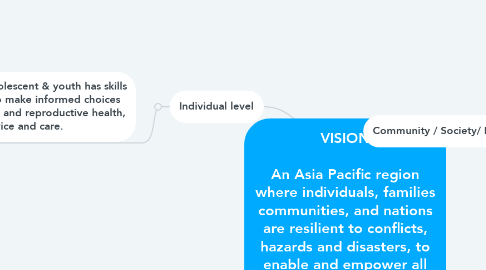
1. Individual level
1.1. Every woman, adolescent & youth has skills and knowledge to make informed choices about their sexual and reproductive health, and access to service and care.
1.1.1. 1. Women, adolescents and youth are able to realize and exercise their SRHR (output 6)
1.1.2. 2. Women, adolescents and youth are systematically supported in their roles as leaders, decision makers, peace builders and agents of change, and included in regional and national platforms (output 6)
2. Institution level
2.1. Institutions provide quality service and care, and enable and empower individuals to make informed choices about their sexual and reproductive health, and to be protected from violence and harmful practices
2.1.1. 1. Strong, capable and involved governance structures implement national disaster frameworks (output 4, 10, 11)
2.1.1.1. (1) Humanitarian coordination mechanism in SRH is in place (e.g. A national SRH sub-cluster/ Working Group) & leadership defined
2.1.1.2. (2) Humanitarian coordination mechanism in GBV is in place (e.g. A national GBV sub-cluster/ Working Group) & leadership defined
2.1.1.3. (3) NGOs and CSOs, particularly women's groups, youth's groups, disability groups, LGBTQI groups are actively engaged
2.1.2. 2. Strong institutional capacity to provide continuity of quality SRH and GBV information and services across the nexus (output 2, 3, 4, 8 10)
2.1.2.1. (1) Health workforce with capacity to deliver quality SRH & GBV services
2.1.2.2. (2) Information management system in place to enable data/evidence-informed policy and programming
2.1.2.3. (3) Supply chain management system to ensure timely delivery of essential life-saving supplies to affected populations
3. Community / Society/ Families
3.1. Communities/Societies/Families create a supportive and enabling environment to empower individuals to make informed choices about their sexual and reproductive health, and access to service and care, to lead and participate in sustainable development, humanitarian action and sustaining peace
3.1.1. 1. Community leadership & social systems promote positive and inclusive norms around SRHR, and eliminating GBV and harmful practices (output 8, 10)
3.1.2. 2. Women, adolescents and youth feel empowered to access SRH & GBV services in a safe, non-judgemental and non-discriminatory manner (output 8, 10)
3.1.3. 3. Women, adolescents and youth are actively engaged as leaders, decision makers, peace builders and agents of change in building resilience of their communities (output 8, 10)
4. National level
4.1. National policies, legal and accountability frameworks advance gender equality and empower women and girls to exercise their reproductive rights and to be protected from violence and harmful practices, and align to regional and global commitments.
4.1.1. 1. A national disaster framework (DRR/DRM) exists and reflects and prioritizes women, adolescent and youth (output 1, 7, 5, 9, 12, 13)
4.1.1.1. (1) Regularly updated through inclusive partner and stakeholder consultations
4.1.1.2. (2) Reflect SRHR (including MISP)
4.1.1.3. (3) Reflect prevention and response to GBV (including harmful practices)
4.1.1.4. (4) Ensure inclusion of vulnerable populations (adolescent, youth, ethnic groups, LGBTI, disabilities)
4.1.1.5. (5) Advance gender equality and women's empowerment
4.1.1.5.1. Ensure gender mainstreaming ...
4.1.2. 2. Governments are on track to implementing global /regional/ inter-governmental frameworks to which they are signatories. (Agenda 2030/ World humanitarian summit / Grand Bargain/ Sendai framework/ APMCDRR) (output 5, 9)
4.1.2.1. (1) Reflecting SRHR (including MISP)
4.1.2.2. (2) Reflect prevention and response to GBV (including harmful practices)
4.1.2.3. (3) Accountability to Affected Populations (AAP)
4.1.2.4. 3. Government actively engaged in partnerships (ASEAN/SAARC/PIFS, UN agencies, private sectors, CSOs/NGOs, donors)
